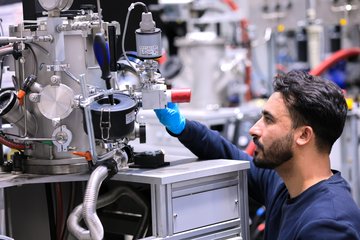All genres
181.
Journal Article
Rapid theory-guided prototyping of ductile Mg alloys: from binary to multi-component materials. New Journal of Physics 17 (9), 093009 (2015)
182.
Journal Article
Synergy of atom-probe structural data and quantum-mechanical calculations in a theory-guided design of extreme-stiffness superlattices containing metastable phases. New Journal of Physics 17 (9), 093004 (2015)
183.
Journal Article
Importance of coordination number and bond length in titanium revealed by electronic structure investigations. Physica Status Solidi B 252 (9), pp. 1907 - 1924 (2015)
184.
Journal Article
Role of biaxial strain and microscopic ordering for structural and electronic properties of InxGa1-xN. Physical Review B 92 (8), 085204, pp. 5204 - 5210 (2015)
185.
Journal Article
Ab initio study of compositional trends in solid solution strengthening in metals with low Peierls stresses. Acta Materialia 98, 12303, pp. 367 - 376 (2015)
186.
Journal Article
From generalized stacking fault energies to dislocation properties: Five-energy-point approach and solid solution effects in magnesium. Physical Review B 92 (6), 064107 (2015)
187.
Journal Article
Improved method of calculating ab initio high-temperature thermodynamic properties with application to ZrC. Physical Review B 91 (21), 214311 (2015)
188.
Journal Article
A first principles investigation of zine induced embrittlement at grain boundaries in bcc iron. Acta Materialia 90, pp. 69 - 76 (2015)
189.
Journal Article
Random phase approximation up to the melting point: Impact of anharmonicity and nonlocal many-body effects on the thermodynamics of Au. Physical Review B 91 (20), 201103 (2015)
190.
Journal Article
Understanding anharmonicity in fcc Materials: From its origin to ab initio strategies beyond the quasiharmonic approximation. Physical Review Letters 114 (19), 195901 (2015)
191.
Journal Article
Ab initio-based bulk and surface thermodynamics of InGaN alloys: Investigating the effects of strain and surface polarity. Physica Status Solidi B 252 (5), pp. 855 - 865 (2015)
192.
Journal Article
Interplay of strain and interdiffusion in Heusler alloy bilayers. Physica Status Solidi (RRL) - Rapid Research Letters 9 (5), pp. 321 - 325 (2015)
193.
Journal Article
Multiscale description of dislocation induced nano-hydrides. Acta Materialia 89, pp. 50 - 59 (2015)
194.
Journal Article
Computationally efficient and quantitatively accurate multiscale simulation of solid-solution strengthening by ab initio calculation. Acta Materialia 85, pp. 53 - 66 (2015)
195.
Journal Article
Connecting semiconductor defect chemistry with electrochemistry: Impact of the electrolyte on the formation and concentration of point defects in ZnO. Surface Science 631, pp. 190 - 195 (2015)
196.
Journal Article
Identification of bulk oxide defects in an electrochemical environment. Faraday Discussions 180, pp. 97 - 112 (2015)
197.
Journal Article
Ordering phenomena and formation of nanostructures in InxGa1−xN layers coherently grown on GaN(0001). Physical Review B 90 (24), 245301 (2014)
198.
Journal Article
Impact of Mn on the solution enthalpy of hydrogen in austenitic Fe–Mn alloys: A first-principles study. Journal of Computational Chemistry 35 (31), pp. 2239 - 2244 (2014)
199.
Journal Article
Origin of the unusually strong luminescence of a-type screw dislocations in GaN. Physical Review B 90 (24), 241201 (2014)
200.
Journal Article
A generalized plane-wave formulation of k · p formalism and continuum-elasticity approach to elastic and electronic properties of semiconductor nanostructures. Computational Materials Science 95, pp. 280 - 287 (2014)











